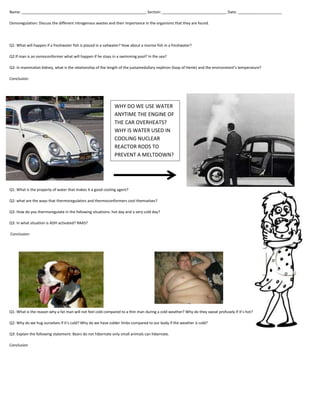
Lab activity 1 20122013
- 1. Name: ____________________________________________________________ Section: _______________________________ Date: _____________________ Osmoregulation: Discuss the different nitrogenous wastes and their importance in the organisms that they are found. Q1: What will happen if a freshwater fish is placed in a saltwater? How about a marine fish in a freshwater? Q2:If man is an osmoconformer what will happen if he stays in a swimming pool? In the sea? Q3: In mammalian kidney, what is the relationship of the length of the juxtamedullary nephron (loop of Henle) and the environment’s temperature? Conclusion: WHY DO WE USE WATER ANYTIME THE ENGINE OF THE CAR OVERHEATS? WHY IS WATER USED IN COOLING NUCLEAR REACTOR RODS TO PREVENT A MELTDOWN? Q1: What is the property of water that makes it a good cooling agent? Q2: what are the ways that thermoregulators and thermoconformers cool themselves? Q3: How do you thermoregulate in the following situations: hot day and a very cold day? Q3: In what situation is ADH activated? RAAS? Conclusion: Q1: What is the reason why a fat man will not feel cold compared to a thin man during a cold weather? Why do they sweat profusely if it’s hot? Q2: Why do we hug ourselves if it’s cold? Why do we have colder limbs compared to our body if the weather is cold? Q3: Explain the following statement: Bears do not hibernate only small animals can hibernate. Conclusion
- 2. 1.__________-process by which waste products of metabolism and other non-useful materials are eliminated from an organism 2.__________ -The maintenance of constant osmotic pressure in the fluids of an organism by the control of water and salt concentrations. 3.__________ -Epithelial tissue whose functions include secretion, selective absorption 4.__________ -Nitrogenous waste found in aquatic organisms that is poisonous and highly toxic in terrestrial organisms. 5.__________ -Nitrogenous waste that is water soluble and relatively has a low toxicity level if used by terrestrial organisms. 6.__________ -Nitrogenous waste that is water insoluble and usually found in insects and birds. 7.__________ -the measure of solute concentration 8.__________ -marine invertebrate that maintains its internal salinity such that it is always equal to the surrounding aquatic environment 9.__________ -active regulation of the osmotic pressure of an organism's fluids to maintain the homeostasisstenohaline 10._________ -Able to tolerate a wide range of salinity 11._________ -Able to tolerate only a narrow range of salinity 12._________ -Substance that protects sharks from the nitrogenous wastes that they release 13._________ -an ametabolic state of life entered by an organism in response to adverse environmental conditions such as desiccation 14._________ -an ametabolic state in organism 15._________ - a sugar molecule that helps organisms such as the water bear (tardigrade) to reach an ametabolic state without comprising their cells. Differentiate these terms: filtration, reabsorption and secretion. Give the parts of the kidney where these processes occur. Give the function of the given structures below (how they act as organs of osmoregulation). Give representative species of these structures. protonephridia/flame- bulb systems/flame cells nephridiopores nephrostome Malpighian tubules Gills Salt glands Give the function of the following structures in the formation of urine in mammals. Liver Kidneys Urine Urinay bladder urethra nephrons glomerulus Bowman’s capsule
- 3. Collecting duct Loop of Henle (thick and thin descending, elbow and ascending) What is the function of these hormones in urine formation in mammals? renin antidiuretic hormone (ADH) aldosterone How does dialysis work in maintaining normal body osmolarity? Define the following. Give real life situation where these processes are used torpor estivation hibernation shivering thermogenesis non-shivering thermogenesis Why is the use of the term cold blooded and warm blooded animals a misconception?